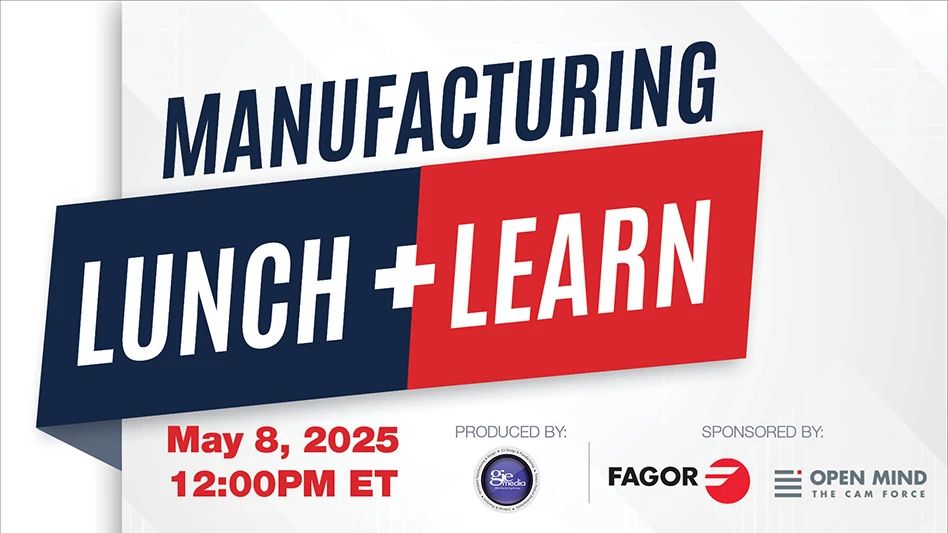.jpg) American baby boomers are aging, and more and more hip joints are being replaced. Medical component manufacturers are adapting not only to cope with demand, but also to be more competitive players in hip joint replacement production.
American baby boomers are aging, and more and more hip joints are being replaced. Medical component manufacturers are adapting not only to cope with demand, but also to be more competitive players in hip joint replacement production.
New machining solutions that provide shorter cycle times, stable processes, good chip management, and a low cost per part are essential to achieving the levels of quality, reliability, and productivity that medical implant manufacturers require.
Machinability challenge
A major obstacle in machining medical implants is the machinability of the component material. The same properties that make cobalt-based materials and titanium alloys popular – their ability to stand up to extreme conditions – make them difficult to machine. Another challenge is in the actual form-cuts to be made in making the cup and head of the hip-joint implant. In addition, the workpiece and fixturing are unstable relative to other operations. Altogether, optimization requires the right approach to both tools and methods.
The material alloys involved are very hard, mechanically strong, and abrasive, resulting in short tool-lives if the means and methods are not adapted to the conditions. Cobalt-chromium alloys are highly wear- and corrosion-resistant, easily cast into complex shapes, and as alloys, also suited to forgings and bar stock. In machining these materials, the design and approach of the cutting edge is more influential than the insert-grade of the cutting edge. The poor heat conductivity of the component material also leads to high cutting-zone temperatures and a tendency for work hardening.
When it comes to titanium, this is relatively straightforward to machine using modern, dedicated cutting tools and the right cutting data. The chip is formed on a small area on the tool-face, which means high, concentrated loads. This component material also has strong chemical reactivity with tool materials at high machining temperatures, which can promote rapid tool wear. Lower thermal conductivity is another property translating to high heat concentration on the tool. The combination of the right tool material, tool path, and cutting data is vital to success. Moreover, high-pressure coolant is an advantageous asset not just for cooling but also chip-control.
Small batch mentality
Medical implants tend to be made in smaller batches, so flexibility is increasingly important in production. Machines are generally 3 - to 5-axis turning centers, 5-axis vertical machining centers, and multi-task machines. Instability tends to be a challenge with fixturing demands and the necessary long tool overhang.
Materials involved vary, with some being forged, some cast, and some in bar-stock, so this adds to the variation in machinability. Tools are also expected to run complete batches before any tool-indexing takes place. The right cutting data is critical in these materials as both excessive and insufficient cutting speed and feed rates lead to inferior results. It is also very important to make sure of sufficient tool engagement and that chip control is in place.
The implant components have a number of features that need to be considered when applying tools and methods:
- External sphere of the acetabula cup
- Internal sphere of the acetabula cup
- External head of the femoral head
- Tapered hole of the femoral head
Circular ramping should be applied for the internal sphere, as this is a very effective method. Any tendency for short tool-life, inconsistency, or tool breakage should be addressed when running, since process security is a priority. Suitable round-insert technology should be applied to achieve high-quality surface finish. Also, the cycle time should be minimized to attain competitive productivity levels.
The machining of the external sphere also should be characterized by maximized tool-life and high security. The external head needs suitable round-insert technology for surface finish, long tool-life, and a reliable edge. An internal feature in the hole on the femoral head is the flat bottom for which the right part of the process needs to be established.
More competitive solutions
Better machining solutions have been provided by new cutting tool developments, offering medical component manufacturers interesting advantages for becoming increasingly competitive. In a world with a growing number of players, this opportunity needs to be taken seriously.
 For example, the roughing operation of the internal sphere of the acetabula cup, made from bar stock, can be optimized as in the following solution: Circular interpolation milling performs a constant spiral that rough-machines the form prior to semi-finishing. The solution employs a modern, indexable-insert ball-nose end mill with two cutting edges, with M-tolerance inserts for high security at the relatively heavy cut and a balanced PVD-coated insert-grade. Through the most suitable tool-path pitch, minimized scallop – closer to the final surface – are left for the semi-finishing operation at the base of the sphere.
For example, the roughing operation of the internal sphere of the acetabula cup, made from bar stock, can be optimized as in the following solution: Circular interpolation milling performs a constant spiral that rough-machines the form prior to semi-finishing. The solution employs a modern, indexable-insert ball-nose end mill with two cutting edges, with M-tolerance inserts for high security at the relatively heavy cut and a balanced PVD-coated insert-grade. Through the most suitable tool-path pitch, minimized scallop – closer to the final surface – are left for the semi-finishing operation at the base of the sphere.
With a cycle time typically less than a minute, this very effective solution leads to a long tool life and the possibility to adopt a high-speed machine strategy. Semi-finishing is subsequently performed effectively in 16 seconds through round-insert profile-turning, followed by finish-turning with a similar tool in 80 seconds.
The tapered hole of the femoral head is another application made efficient through applying engineered cutting tools that really suit the operation. The hole is drilled with a solid-carbide drill. Then the roughing and finishing of the hole has the taper made with a dedicated tool-solution: A specially designed boring bar performs the internal rough turning and finishes the flat hole-bottom in one pass. With proven short-hole, indexable-insert technology, the optimized solution is effective and secure, leaving the finishing of the taper to be turned by a standard, positive-geometry insert. The boring bar uses an all-round modern insert grade dedicated for super-alloy machining. Total cycle time for the finished tapered hole is 2 minutes.
New round-insert technology
There are various radii in the implant cups, which means that different insert shapes and geometries have to be applied for roughing, semi-finishing, and finishing operations. When the radius of the hip-joint cup is restricted, the round-insert solution may be limited to roughing, complemented by a D-shaped insert having a suitable-sized nose radius. Solutions may vary somewhat for the hip-joint heads depending upon whether forged or bar-stock material is used.
The radius of the round insert represents the approach of the edge to the material, so that the chip thickness is reduced in relation to the feed rate. The round cutting edge engagement is longer and leads to lower machining temperatures, resulting in a potential for higher cutting data, leading to higher productivity as well as more consistent tool-life when the right insert grade is used. When applied suitably, tools and methods eliminate or minimize destructive, discontinuous tool wear. A four-fold increase of the insert-nose radius can lead to a six-fold increase of the tool-life in cobalt-chromium alloys.
One of the most critical aspects of manufacturing hip-joint implants is the quality of the finished part. A machine shop might have spent three times more money on grinding and polishing costs than on cutting tools. Improving quality, while reducing the role of these costlier processes in favor of metal cutting, leads to significant manufacturing cost savings. Establishing the right turning operation, with the most suitable tool and cutting data, is a very advantageous exercise.
Previous development of machining solutions on a broader scale for these demanding workpiece materials, such as in aerospace, has paved the way for dedicated solutions for medical applications. Both coated and uncoated cemented carbide insert-grades are suitable, depending upon the operational requirements. New developments have seen unique PVD-coated grades, where the coating has very strong adhesion to the insert substrate. This grade-technology has proved beneficial for the sharp, tough, positive-cutting geometries that are needed for demanding alloys.
.jpg) Manufacturing successes
Manufacturing successes
One application, involving the machining of an internal sphere with a 60mm diameter in CoCrF75 material, experienced double output when a more suitable round-insert tool for the turning was applied. This was mainly through the cutting speed being almost doubled, from 40m/min to 75m/min. Another application, involving a 66mm diameter, saw the cycle time reduced from 2.0 minutes to 1.3 minutes and the tool-life increased from three to 10 components per edge. Again, another application, involving sphere diameter of 35mm in the same material, resulted in the productivity being doubled and tool-costs reduced by a third.
It has been proven conclusively that new machining solutions provide shorter cycle times, stable processes, and good chip management. Low costs per part are essential along with the means to achieve the necessary levels of quality, reliability, and productivity in the medical component manufacturing industry.
Sandvik Coromant
www.sandvik.coromant.com/us
Elizabeth Engler Modic is the editor for TMD and can be reached at 330.285.5421 or emodic@gie.net.
Get curated news on YOUR industry.
Enter your email to receive our newsletters.

Explore the January February 2014 Issue
Check out more from this issue and find your next story to read.
Latest from Today's Medical Developments
- Siemens accelerates path toward AI-driven industries through innovation and partnerships
- REGO-FIX’s ForceMaster and powRgrip product lines
- Roundup of some news hires around the manufacturing industry
- Mazak’s INTEGREX j-Series NEO Machines
- The Association for Advancing Automation (A3) releases vision for a U.S. national robotics strategy
- Mitutoyo America’s SJ-220 Surftest
- #56 - Manufacturing Matters - How Robotics and Automation are Transforming Manufacturing
- STUDER looks back on a solid 2024 financial year






